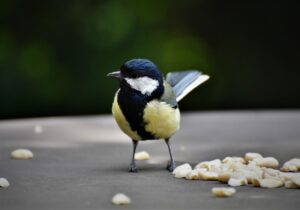If you’ve ever owned a bird feeder, bird table or anything of that nature, you’ll know how frustrating it can be when pesky pests such as squirrels and rats decide to help themselves to the birdseed. I know that squirrels are just doing what comes naturally to them, but they absolutely decimate any food or seed that’s on offer, leaving none for the birds!
The question is, how do you stop this? Is there any surefire way of making sure these critters don’t gobble every morsel of food before the birds get their fair share?
The answer to these questions isn’t exactly straightforward. Sure, you can buy bird feeders that claim to repel squirrels, i.e. be squirrel proof, but are they actually able to protect your birdseed?
Well, in today’s piece, we’re going to examine one of the most popular ‘squirrel proof’ bird feeders currently available on the market, the Roamwild PestOff Squirrel Proof Bird Feeder, to see if a bird feeder can be 100% squirrel proof. To do so, we’re not only going to review it based on its design, construction, and function, but we’ve also field tested it for six weeks to see how it fared in the heat of battle. Ok, so not quite battle, but you know what I mean!
Could this be the saviour of birdseed? Or will it, like many other supposed ‘squirrel proof’ bird feeders out there, rapidly fail when the squirrels get a whiff of bird feed in their nostrils and aggressively try to break their way in? Can it stop rats, crows, and other big birds from eating all the food?
Let’s find out.
Roamwild Pestoff Bird Feeder: An Introduction
According to the marketing blurb, RoamWild PestOff bird feeders use patented technology to stop pests from wolfing down all of the birdseed that you’ve generously left for the smaller bird species in your garden. But how does it work?
Well, according to their website, their patented pest-proof technology works by shutting off access to the food when something heavier than a small bird lands on the porch. When something heavier lands or hangs on the perch, it pulls down the hatch, covers the feeding holes and, therefore, blocking off access to the birdseed inside. Once the pest jumps or flies off, the perch moves back into place (via a spring-loaded action), allowing smaller birds to feed as and when they please. This also occurs if too many birds are trying to feed at once.
On the face of it, this sounds great. A simple mechanism that can stop pests from getting to the birdseed…but does it work? We’ll discuss our ‘field test’ findings later. Before that, let’s take a look at what else the RoamWild PestOff bird feeder has to offer.
Aside from the plastic tube that houses the seed, all other components are made from metal, meaning nothing is going to peck, gnaw, or chew their way through it any time soon! This is, obviously, a very good thing. The number of times I have purchased what purports to be a pest-resistant durable plastic bird feeder only to find it chewed through in a matter of weeks is bordering on ridiculous, so a full-metal design is undoubtedly, in my opinion, the way to go.
Furthermore, according to the advertising spiel, it’s also 100% waterproof (something we also tested), meaning that there’s no chance of seed getting wet, mouldy, and potentially full of bacteria that might harm the birds. Sadly, a lot of bird feeders that claim to be waterproof aren’t (or aren’t 100%), so finding one that is 100% waterproof is actually quite rare. Whether it is or not, well, you’ll just have to wait and find out!
The tube itself can hold 1.5 litres of seed, which is a fair amount and will last for many, many weeks. Although some will advise against larger birder due to the fact that seed can get wet and mouldy, in addition to the fact that they’re typically harder to clean, if this model is 100% waterproof, it will mean that its size won’t count against it and will actually make it a more appealing product.
Roamwild Pestoff Bird Feeder: Our Field Tests
We don’t do thing by half here at BarfPetFoods simply because we want to furnish you with completely unbiased, informative, and accurate advice and reviews. We want you to know which produces are worth your hard-earned cash and those that aren’t, so we’ll never pull any punches, and we’ll always be 100% transparent and honest – and this goes for our review of RoamWild’s PestOff bird feeder, too. So, without further ado, let’s begin.
Initial impressions
The first word that springs to mind when handling the feeder is ‘sturdy’. It just feels robust, solid, and like it will be durable. As we mentioned above, we prefer an all-metal design as metal is certainly more pest-proof than plastic, so this feeder definitely scores highly in his regard. Given its construction, it is more weighty than a plastic bird feeder of a similar size, but it’s not so heavy as to cause issues, i.e. being too heavy to hang up, get into position etc.
From an aesthetics perspective, it looks pretty good. While no bird feeder isn’t going to win an award for being the most beautiful thing in the universe, there certainly better-looking bird feeders, and we’d put this bird feeder in this category. Dark green works well in any garden, so it’ll fit in regardless of the colour of your plants, hedges, fences, shed, etc.
Overall, it feels solid and looks pretty good, so it’s a good start.
Is it easy to clean & fill?
One test we always carry out when testing any bird feeder is the ‘clean and fill’ test. As the name indicates, this test involves seeing how easy (or difficult) the feeder is to both fill and clean. This is a very important test because the last thing anyone wants is a bird feeder that’s a pain in the backside to fill and/or clean! Tube feeders are often thought of as being difficult to clean as it’s sometimes hard to get right to the bottom, particularly if they’re big/long. But how does the RoamWild PestOff bird feeder fare in these regards?
According to the marketing blurb, this model is super easy to fill…which it actually is. The lid is really easy to remove and put back into place, which makes filling and re-filling no trouble whatsoever. But what about cleaning it? We always clean our bird feeders prior to putting them out in the garden to make sure they’re 100% clean and bacteria-free before we put bird food inside them, and this gives us an opportunity to test how easy it is to clean at the same time.
Given that this tube is rather long, getting right to the bottom with your fingers/hand is not possible; however, a standard washing-up brush will more than suffice for this. Plus, if you do have any particular tough or stuck-on seed remnants at the bottom of the feeder, a powerful garden hose will make easy work of removing them. Although we wouldn’t say this is the most trouble-free tube bird feeder we’ve reviewed, it’s not going to cause you any grief when cleaning it, that’s for sure!
Is it waterproof?
When testing how waterproof a bird feeder is, we carry out two tests: an initial test using a hose and a bucket of water and a field test where we see how well the feeder fares in our garden under normal circumstances in the natural environment.
How did it perform?
Well, the hose and bucket test was a success. No water managed to get inside the feeder, which is, of course, a good thing. We really like to put products through their paces, and the bucket and hose test is the best way to do this! The only small issue that came to mind when carrying out the initial test is the fact that the seed is slightly exposed through the feeding port, meaning that if water were to get into that, then a small amount of seed may become wet. However, given that the port is well protected, it would require a horizontal blast of water. Plus, given the fact that any wet seed would be eaten very quickly, we don’t think this is of significant consequence.
How did the feeder perform ‘in the field’? Well, after six weeks in our garden with daily checks to see if the seed was damp, we were satisfied that this is a waterproof bird feeder. Even during periods of heavy rain, the seed didn’t get wet, and we found no evidence of mould, dampness and the like.
The only question mark we have is over whether or not it will rust over time. According to the manufacturer, it shouldn’t rust, but over many years, there’s the (minimal) chance it may rust and, therefore, become porous and not as waterproof. However, this is unlikely. Overall, we’re happy to class this as a waterproof bird feeder.
Is it squirrel/pest-proof?
This is the big test! We’re pretty fortunate (or unfortunate!) where we live because there are plenty of squirrels and big birds (and the occasional rat) to rest our bird feeders to the limit. We know that within a day or two of us putting feed out, the squirrels will bound in and try to get their paws on it, and this is exactly what happened this time.
But did they manage to get their paws on the birdseed?
Although it’s impossible for us to answer with 100% accuracy simply because we weren’t monitoring it 24/7, it was glaringly evident that the perch mechanism worked if anything heavier than a small blackbird perched itself on it, leaving the critter unable to reach the feed. Throughout the six week period we saw, squirrels, crows, magpies, and large blackbirds foiled by the mechanism, which, I have to admit, was quite funny at times! Although it was a little disheartening to see the odd large sparrow or blackbird be thwarted, overall, it did its job and kept the seed safe for the smaller bird species. Plus, we saw no evidence of visible chewing, gnawing, scratching and like, which meant after six weeks, it still looked relatively new.
Roamwild Pestoff Bird Feeder: Our Verdict
All in all, the RoamWild PestOff bird feeder does what it says on the tin. Based on our tests, it stopped pest from accessing the food, it kept the food dry, and it was relatively easy to fill/re-fill and clean. While there is the possibility that a tiny amount of exposed birdseed in the feeding port could become wet, we don’t think this is an issue. Overall, we’re confident in saying that this is the best squirrel (and pest) proof bird feeder we’ve ever used and/or revised, so we’d certainly recommend it. Sure, it’s more expensive than most other bird feeders currently available on the market, but it is designed to last, and I’m sure you’ll get many, many years of use out of it.


